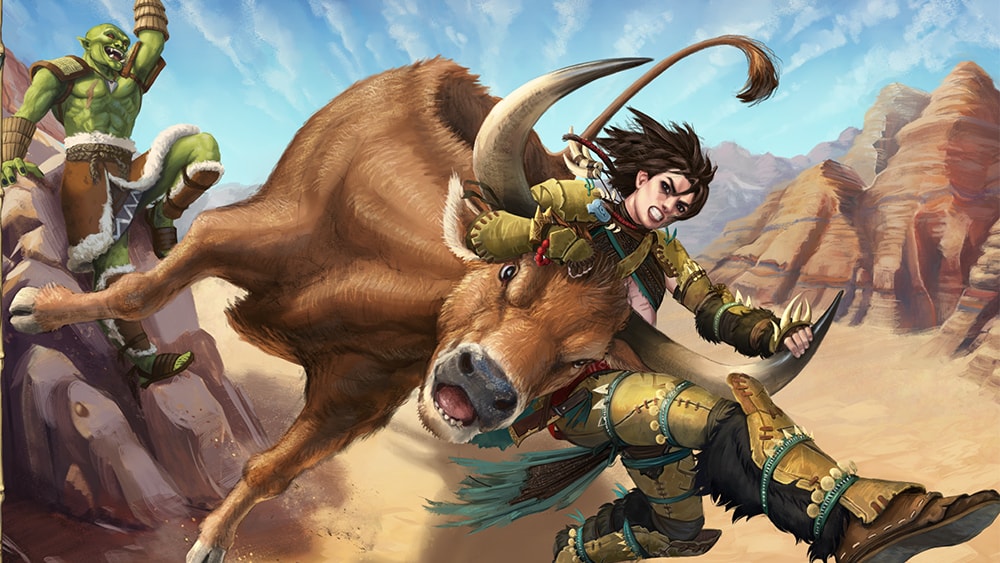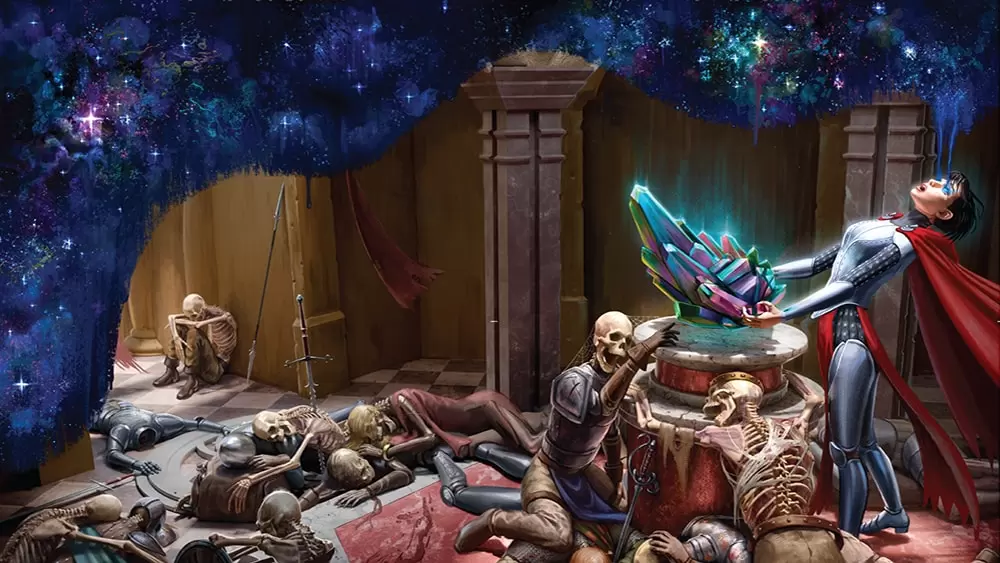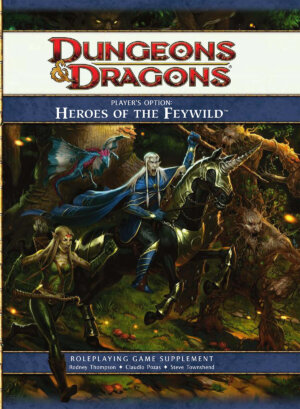
Publisher: Wizards of the Coast
Authors: Jeremy Crawford, Ari Marmell, Mike Mearls, Claudio Pozas, Stephen Schubert, Matthew Sernett, Rodney Thompson, and Steven A. Townshend
Artists: Ryan Barger, Eric Belisle, Greg Bilsland, and more
Year: 2011
Pages: 162 pages
Genre: Feywild player character options book for Dungeons & Dragons
MSRP: $29.95 for the hardcover or $14.99 at DMs Guild
The Feywild is the realm where all of the creatures from our own mythology of the faerie world originate. This player’s supplement for Dungeons and Dragons gives players the opportunity to integrate a touch of the wild magic into their characters and even take on the role of a Fey creature. Ever want to play a pixie? Now you can as the pixie is one of several races included in Heroes of the Feywild.
The book itself is the standard high quality Wizards of the Coast hardcover book. It is filled with illustrations and full color artwork, many with captions to let you know which particular D&D heroes you are looking at and what they are doing. The book also includes many little sidebar stories, called Bard’s Tales, that add much to the flavor of the guide. Some might consider it fluff, but I think it is a nice touch to have these vignettes included.
The guide can be used whether you are playing 4th edition or the Essentials line. Let’s break it down into bite size chunks.
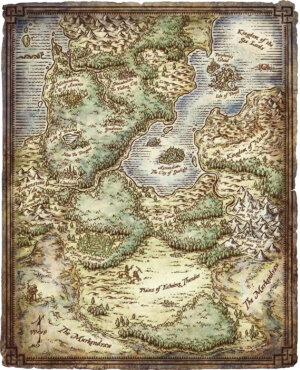
Chapter Two introduces the new races for those interested in playing a Fey character. The Hamadryad’s are female characters that are the incarnate spirits of living oak trees. They have evolved from wood nymphs and given up their immortality along with their innocence in order to become a more powerful, thinking force in the Fey. They can transform into a wooden form and can enchant a foe with their beauty. Hamadryads gain utility powers as they advance including Wooden Sanctuary, which allows them to disappear into a nearby wooden object until the next turn, and the Fey Mind Mirror, which allows you to turn a foe’s mind effect against them.
The Pixie is my favorite new race. They are merely a foot tall and are considered small creatures. This means they can occupy the same space as another adventurer or foe. They can fly, but only up to one space in height. Pixies also have Pixie dust, which can enable the target to fly as an action, up to six spaces. One great feature is that they can shrink objects, so you don’t have to miss out on all of the nice loot that you come across. Pixie utility powers include invisibility and teleportation.
Finally, the Satyr is the goat legged male we’ve all heard about. They can slide enemies away from them up to three squares if they are attacked. They are friendly and will go out of their way to develop new friendships rather than attacking everything they run across. They will fight dirty when necessary though. Satyrs are tough. Their utility powers include Bending the Balance, which can help the hit points of a friend or hurt the hit points of a foe, 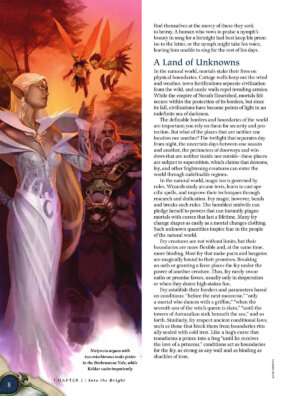
Chapter Three introduces new classes. The Barbarian Berserker emits an aura that gives enemies a -2 penalty when not attacking you. You can enter a berserker fury, adding damage to your attacks and increasing the effectiveness of some of your powers. Berserker powers include Stalk and Strike, which enables you to move up to two squares before attacking, and Sweeping Cut, which can level all of the enemies surrounding you.
The Bard Skald emits an aura that allows them to heal themselves or another adventurer for a minor action. They get additional choices for daily attack powers, and can sing songs to help characters heal additional points when resting. Powers include Bardic Lore, which enables you to make a knowledge check as if you rolled a 20, and Climactic Crescendo, which allows you to turn a successful attack into a critical hit.
The Druid Protector can summon growth from the earth to grab and entangle their foes. You have Primal Attunement, allowing you to choose from many power options. You may want to Call the Spirits, or Summon Natural Ally (Giant cobra anyone?). Your utility powers include changing form and melding into stone.
The new Witch subclass of Wizard is as true to legend as is possible. You can charm and transform your foes; you gain a familiar that can allow you to change the powers you have selected if you find you need a new one for a particular situation. There are Witch cantrips to choose from, and many new powers to flesh out your character. Powers include the Witch Bolt (think of the Emperor from Star Wars) and Mass Transformation, for turning that crowd of Orcs into a bunch of hopping toads.
Chapter Four features character themes that you can use to incorporate a new character as a part of the Fey. 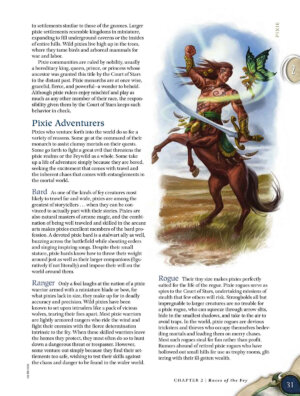
Chapter Four also includes Paragon Paths for the new Classes, as well as Epic Destinies and new Feats. There is a section on Feywild gear and magic items too.
Chapter Five is the final chapter. It is entitled “Build Your Story” and has a lot of information for you to build a complete back-story as it relates to the Feywild for your character. It is pretty interesting in and of itself, even if you are not trying to incorporate it into your character. The appendix at the end is a revised character advancement table up to level 30.
This is a wonderful book for those interested in incorporating the Fey into their adventures. You have plenty of opportunity to simply have your character touched by the Fey, or becoming a fully fledged Feywild adventurer. It pulls some information from other D&D resources, and also makes reference to these resources. So if you are rolling up a Barbarian, you will still need the Players Handbook 2 in order to accomplish it.
[rwp-review id=”0″]
- A Dungeon Delve for Kids?: A Review of Dungeon! - Oct 24, 2022
- Better, Stronger, Faster | Descent: Journeys in the Dark Second Edition Reviewed - Oct 23, 2022
- Your Planet is Doomed!: Invasion from Outer Space Reviewed - Oct 22, 2022







